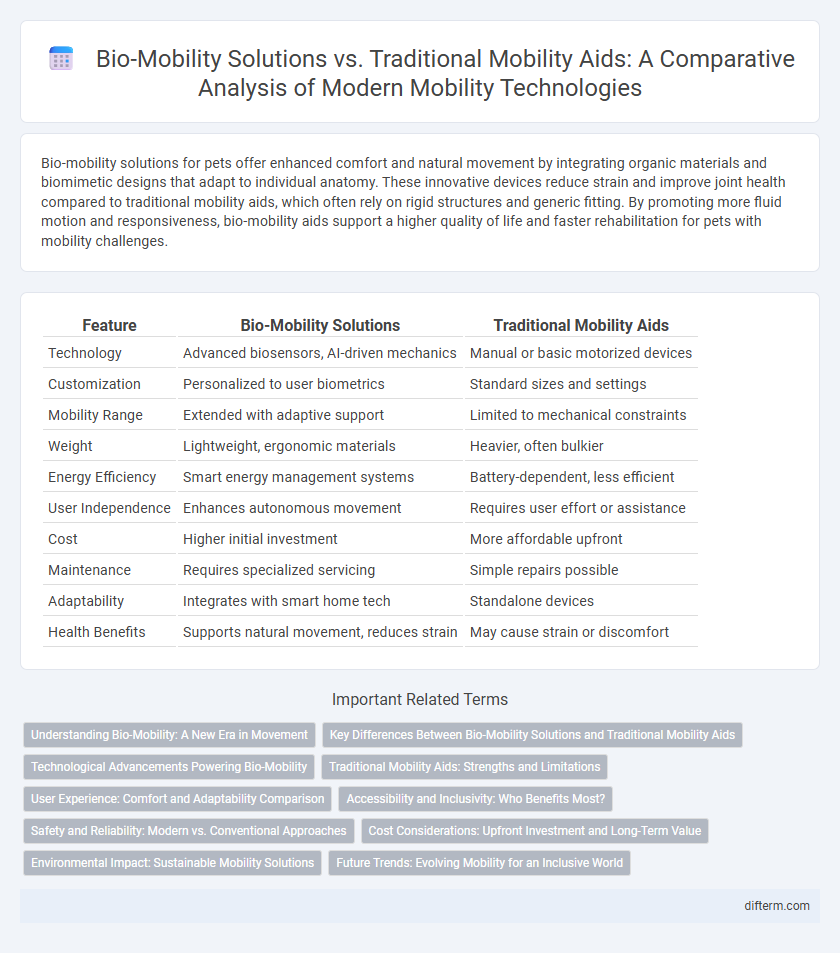Bio-mobility solutions for pets offer enhanced comfort and natural movement by integrating organic materials and biomimetic designs that adapt to individual anatomy. These innovative devices reduce strain and improve joint health compared to traditional mobility aids, which often rely on rigid structures and generic fitting. By promoting more fluid motion and responsiveness, bio-mobility aids support a higher quality of life and faster rehabilitation for pets with mobility challenges.
Table of Comparison
| Feature | Bio-Mobility Solutions | Traditional Mobility Aids |
|---|---|---|
| Technology | Advanced biosensors, AI-driven mechanics | Manual or basic motorized devices |
| Customization | Personalized to user biometrics | Standard sizes and settings |
| Mobility Range | Extended with adaptive support | Limited to mechanical constraints |
| Weight | Lightweight, ergonomic materials | Heavier, often bulkier |
| Energy Efficiency | Smart energy management systems | Battery-dependent, less efficient |
| User Independence | Enhances autonomous movement | Requires user effort or assistance |
| Cost | Higher initial investment | More affordable upfront |
| Maintenance | Requires specialized servicing | Simple repairs possible |
| Adaptability | Integrates with smart home tech | Standalone devices |
| Health Benefits | Supports natural movement, reduces strain | May cause strain or discomfort |
Understanding Bio-Mobility: A New Era in Movement
Bio-mobility solutions integrate advanced biotechnology and wearable robotics to enhance natural movement patterns, offering greater flexibility and adaptability compared to traditional mobility aids like canes or walkers. These innovations promote improved gait dynamics and muscle engagement, leading to increased independence and reduced physical strain. Emerging technologies in bio-mobility are transforming rehabilitation by providing personalized support tailored to individual neuromuscular needs.
Key Differences Between Bio-Mobility Solutions and Traditional Mobility Aids
Bio-mobility solutions leverage advanced biomaterials and sensor technologies to enhance user adaptability and natural movement, unlike traditional mobility aids that rely primarily on mechanical support structures. These innovative systems integrate real-time feedback mechanisms for dynamic gait adjustments, offering personalized mobility experiences not achievable with conventional walkers or canes. Energy efficiency and ergonomic design in bio-mobility devices significantly reduce user fatigue compared to traditional aids, promoting longer and more comfortable usage.
Technological Advancements Powering Bio-Mobility
Bio-mobility solutions integrate cutting-edge technologies such as sensor-driven prosthetics, AI-powered exoskeletons, and neural interface controls to deliver superior adaptability and responsiveness compared to traditional mobility aids like canes or manual wheelchairs. These advancements enable real-time movement analysis, enhanced user intention prediction, and seamless biofeedback loops, significantly improving mobility independence and reducing user fatigue. Emerging innovations in materials science and machine learning further optimize durability and personalized functionality, positioning bio-mobility as a transformative force in mobility assistance technology.
Traditional Mobility Aids: Strengths and Limitations
Traditional mobility aids such as canes, walkers, and wheelchairs offer reliable support, ease of access, and affordability for individuals with mobility challenges. These devices excel in providing immediate stability and enhancing independence but often lack adaptability and advanced ergonomic features found in bio-mobility solutions. Limitations include reduced comfort during extended use and insufficient integration with emerging technologies that promote natural movement patterns.
User Experience: Comfort and Adaptability Comparison
Bio-mobility solutions prioritize ergonomic design and intelligent materials, offering enhanced comfort by adapting to users' body movements and reducing pressure points compared to traditional mobility aids. Advanced sensors and customizable settings in bio-mobility devices provide personalized support and responsiveness, improving overall adaptability for diverse user needs and environments. This integration of biofeedback and smart technology significantly elevates user experience, promoting longer use duration and greater independence.
Accessibility and Inclusivity: Who Benefits Most?
Bio-mobility solutions offer enhanced accessibility by integrating adaptive technologies that cater to diverse physical abilities, surpassing traditional mobility aids in user customization and ease of use. Populations with complex mobility challenges, such as individuals with neurodegenerative disorders or severe limb impairments, gain significant benefits from these advanced systems that promote autonomy and inclusive participation. The shift towards bio-mobility fosters broader societal inclusion by addressing barriers faced by users often underserved by conventional devices.
Safety and Reliability: Modern vs. Conventional Approaches
Bio-mobility solutions leverage advanced biomaterials and real-time sensor technology to enhance safety and reliability beyond conventional mobility aids like standard walkers and canes. Modern devices integrate adaptive stability mechanisms and predictive analytics that minimize fall risks, outperforming traditional equipment constrained by rigid designs and lack of environmental feedback. These innovations result in more responsive support systems, providing consistent assistance tailored to user needs in dynamic environments.
Cost Considerations: Upfront Investment and Long-Term Value
Bio-mobility solutions often require a higher upfront investment compared to traditional mobility aids due to advanced technology and personalized design features. Despite the initial cost, bio-mobility devices offer long-term value through enhanced durability, improved user satisfaction, and potential health benefits that reduce ancillary medical expenses. Evaluating total cost of ownership reveals that bio-mobility solutions can present a more cost-effective option over time thanks to lower maintenance and replacement rates.
Environmental Impact: Sustainable Mobility Solutions
Bio-mobility solutions utilize renewable materials and energy-efficient technologies, drastically reducing carbon emissions compared to traditional mobility aids that often rely on non-renewable resources. These sustainable mobility options contribute to lower environmental footprints through biodegradable components and minimal energy consumption. Implementing bio-mobility enhances ecological conservation while promoting greener urban transportation systems.
Future Trends: Evolving Mobility for an Inclusive World
Bio-mobility solutions integrate biotechnology and advanced materials to enhance user autonomy, outperforming traditional mobility aids in adaptability and comfort. Future trends emphasize personalized, AI-driven interfaces and sustainable design, promoting inclusivity for diverse physical abilities. Innovations like neural-controlled prosthetics and biodegradable components revolutionize mobility, making accessibility more seamless and eco-friendly.
Bio-mobility solutions vs traditional mobility aids Infographic

 difterm.com
difterm.com